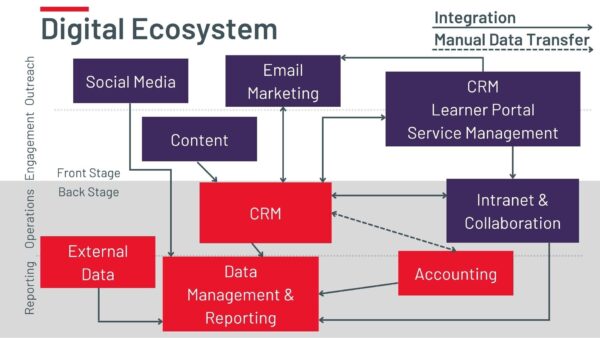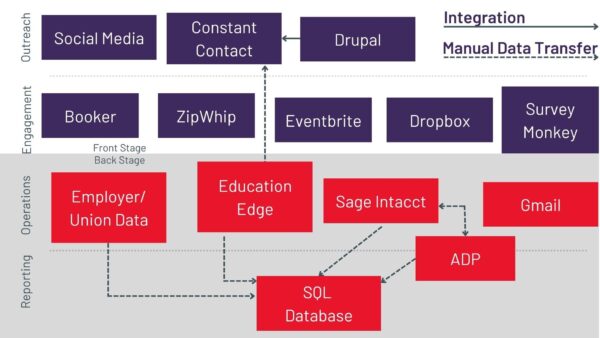Blog Insights
Mapping Your Digital Ecosystem
Having a clear sense of how all of your digital tools and platforms are (and aren’t) connected is an important step in ensuring that you have the right tools in your toolbox to reach your goals. However, mapping your digital ecosystem is easier said than done.
You may be trying to organize all your systems and applications within your organization but not be 100% certain how to approach it. There may be multiple ways of doing similar tasks within your organization and you may want to make sure you’re more organized, processes are streamlined, and members of your organization are working together efficiently. Making sure that you’ve got a complete and correct digital ecosystem is a great way to get there.
Digital engagement strategies are quickly evolving and new tools are becoming available all the time. Organizations are constantly trying to stay abreast and in line with the most effective technologies and strategies to (a) help their organization achieve impact, and (b) operate effectively within a budget. A digital ecosystem map allows organizations to measure their footprint and make sure they are making the most for their operational budget.
What is a digital ecosystem map?
A digital ecosystem map is a visual diagram of all the online tools and platforms used within an organization. It illustrates processes, how data moves between components, and whether it is automated or manual. And just as importantly, it also shows where systems are not currently connected or able to speak or transfer data to one another. A good digital ecosystem map can also illustrate the users of each system and who is responsible for maintaining them.

Why does this matter?
As organizations grow in size, they can begin to amass internal tools and applications as different departments or individuals move initiatives forward. Organizations can end up with multiple project management tools, multiple chat systems, and ultimately multiple people using different tools and strategies to accomplish the same goals. As time passes, the number of applications and tools in an organization naturally expands. Departments become managed differently, and as some silos are inevitably created, some organizations find themselves with 3-5 different ways of doing the same thing — which may not be the best use of the overall budget. With the accumulation of systems, applications, responsibilities, and personnel, it is important to periodically (and regularly) step back and examine how all these systems work together and who is in charge to remove the duplication of efforts, and identify where efficiencies and improvements can be made.
Creating your digital ecosystem map
Here are the steps to building out your map:
- Create a list of tools. The first thing you need to do is take an inventory of all the applications and systems your organization uses. This list will act as your digital ecosystem starting point.
- Document who uses them. Next, identify who uses which system and application, and who is ultimately responsible for each. This will be important to ensure all necessary stakeholders are part of the process.
- Categorize the purpose of each tool. Determine what each system and application does and for which department or purpose. For example, maybe you have three tools that the marketing team uses, two of which are used by the development team periodically. Categorize your systems by ownership and department.
- Draw connections between tools. Note where data or information passes between tools, and indicate whether this is done manually or automatically. Show tasks that are being duplicated, and where two or more systems have similar functionalities.
- Determine the effectiveness of each tool. In addition to strengths, look to see if any tool is underperforming and needs to be either replaced, upgraded, or consolidated. It’s important to get direct feedback from the people who actually use these tools day-to-day.
- Prioritize each tool. Within your map, prioritize according to how critical each tool is to your organization. Additionally, if you’re going to be replacing or adopting any new tools, think about their priority in terms of their immediate need to the organization and the potential order in which they would need to be implemented.

Once you’ve got your map, now what?
Now that you have a good sense of your organization’s current state of play, now is the fun part to map out a future state of your digital applications, where you are able to be more efficient and connected in the way that you work online. See where integrating systems would serve to benefit your organization as a whole, and where data can be better connected. Creating a fresh landscape will allow you to recommend which systems can be removed or consolidated.
A digital ecosystem map is a key component of any digital transformation initiative you may be exploring. The goal is to make sure that you are clear about what you have to work with, that you have the right tools to support your mission’s goals, and that you are being as effective and efficient as you can be to achieve them.
